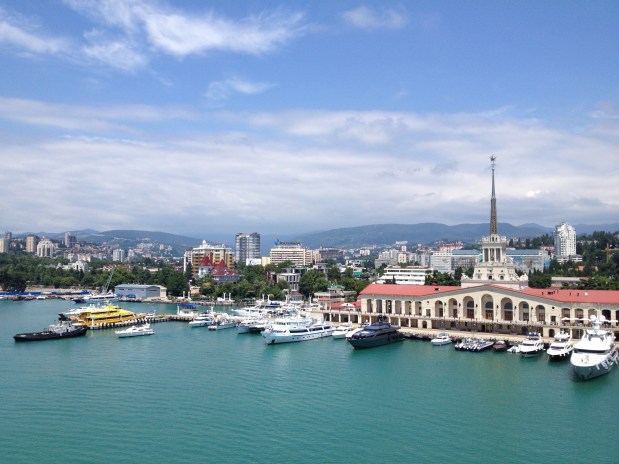Who knew that a summer vacation could turn into a such a valuable lesson in Eastern European politics, history, and geography for my boys? Our recent cruise to the Black Sea included stops in Greece, Turkey (covered in my recent post “Where East Meets West”), Russia (“Sochi: Sub-tropical Olympic City”), and Ukraine. Thanks to this unique family trip, my kids have a deeper understanding of the ever-changing current events unfolding in this part of the world. How fortunate to have experienced Crimea during peaceful times.
Our Regent ship’s itinerary included a stop in Sevastopol, the coastal, Black Sea city in the southwestern part of the Crimean Peninsula; its subtropical climate has made it a popular seaside resort destination. Crimea extends out into the Black Sea—it’s basically an island, except for the narrow strip of land that connects it to the Ukrainian mainland in the north; (it’s eastern shore is separated from mainland Russia by just a narrow strait of water.) During its complex 2,000-year history, this territory has changed hands numerous times – Greeks, Romans, Byzantines, Ottomans, and Russians have all called it their home. In 1991, after the collapse of the Soviet Union, it became a Republic of the newly independent Ukraine, and home to the Russian Black Sea fleet. Since then, the city’s status has remained calm until recent events—Russia’s annexation.
On an already warm, cerulean-sky morning, we embarked on a walking tour of Sevastopol’s sun-drenched, bustling port area. It was surprising to see the Mediterranean-style architecture, palm tree-lined boulevards, and colorful sailboats floating through the harbor area. The city’s seaside promenade was filled with souvenir shops and terrace-fronted restaurants with menus written in Cyrillic script—not surprising since the majority of the population is Russian. Rich with thousands of years of history, our local guide pointed out that Sevastopol is a living museum—1,800 monuments dot the city.

The “Monument to Scuttled Ships”–Russian ships, flooded to form a line of defense from the Allies during the 1854 Siege of Sevastopol
The next stop was Chersonesus, the archeological remains of the ancient Greek colony dating from the 5th century BC, nicknamed the “Ukrainian Pompeii” or the “Russian Troy.” Wandering amongst Greek theatres, Roman temples and columns, we watched the locals as they took advantage of the seaside location, diving into the dark blue waters from the narrow strip of beach that abutted the ruins.

In Greek, Chersonesus means “peninsula,” an appropriate name for this ancient seaside colony
Nearby is the recently restored Byzantine-style St. Vladimir Cathedral, built in the 19th Century; it’s the cradle of Russian Orthodox Christianity. Covering our arms and legs in respect before entering, we studied the dramatic marble-clad interior punctuated by bold frescoes, mosaic tile-inlaid floors, and vibrant stained glass windows, committing it all to memory since interior photography was forbidden. Outside, we took a break from the sun’s heat, pooling our Ukrainian hryvnia to buy soda bottles and freshly baked pampushki (garlicky rolls) from a nearby vendor.

St. Vladimir Cathedral commemorates the baptism of Prince Vladimir the Great of Kiev
A must-see is the Panorama Museum, which memoralizes the defense of the city during the 1853-1856 Crimean War. Opened in 1905 on the 50th Anniversary of the defense of Sevastopol, the cylindrical building houses the impressive 377-foot long, 46-foot high circular canvas of the famous battle as depicted by artist Franz Roubaud. An 80-step climb to the top of the display reveals the massive work of art, an impressively accurate portrayal, which is best viewed by walking around the elevated observation platform in the center of the hall.
Outside the museum, the boys stopped in the parking lot to admire a vendor’s display of Soviet-era memorabilia artfully arranged on the hood and roof of his beat up, Trabant. As they picked out brass military pins and wool caps, the gentleman patiently explained the unit each item hailed from—Air Force, Army, Navy—with some vintage Aeroflot wings and KGB insignias thrown into the mix.

A “vintage” Trabant–a popular Eastern European car–makes an appropriate backdrop for a display of Soviet-era memorabilia
Now, at home as we turn on CNN, read the Times, and watch as another chapter of Crimean history is written, we feel very fortunate to have visited the Crimean Peninsula and learn about its multi-faceted heritage and culture. We only hope that recent events are settled peacefully, not only for the residents, but also for those who have not yet had the opportunity to experience and appreciate first hand its rich and unique history.
 Ready to plan a unique trip for you or your family? Contact me at mollie@herrickstravel.com. For more information on my trip planning services, please click here.
Ready to plan a unique trip for you or your family? Contact me at mollie@herrickstravel.com. For more information on my trip planning services, please click here.
EMAIL SUBSCRIBERS: to view my previous posts, and my ENTIRE blog, please click here: uniquefamilytraveler.com. To become a SUBSCRIBER of unique family traveler, please enter your email address in the box on the upper right hand side of the blog (or scroll ALL the way to the bottom), and then make sure to respond to the follow-up email (check spam folder). Thank you!







